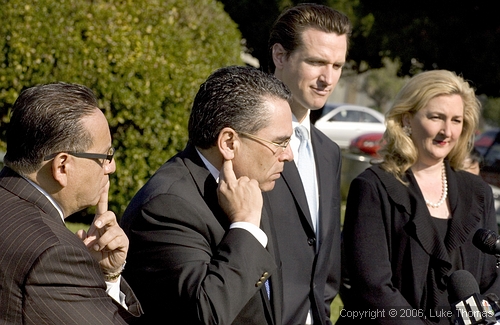Bay Area seeks half Federal funds available
for disaster preparedness


San Francisco Mayor Gavin Newsom, San Francisco director of Emergency
Services Annemarie Conroy, Oakland City Council President Ignacio
De La Fuente and San Jose Mayor Ron Gonzales join a scheduled
press conference on Treasure Island to ask for emergency preparedness
dollars from the Federal Government.
Photo(s) by
Luke Thomas
By Pat Murphy
February 24, 2006
Ten Bay Area counties today jointly asked for nearly half the
Federal funds available for homeland security preparation.
Some $107 million of the $333 million Bay Area request would
permit all 132 agencies to communicate instantly, reported San
Francisco director of Emergency Services Annemarie Conroy.
Conroy joined San Francisco Mayor Gavin Newsom, San Jose Mayor
Ron Gonzales, and Oakland City Council President Ignacio De La
Fuente on Treasure Island to detail regional funding request.
"This super-urban area involves a population of seven million
people and 88 square miles," Conroy stated.
"The major areas that we are applying for ... range from
infrastructure protection, mass prophylactics programs, mass surge
capacities for meters, mass casualties programs, and mass care
and shelter."
Newsom described regional disaster preparedness planning as long
overdue.
"This is a first for us," noted Newsom.
"It's an important discipline - regionalism - and quite
frankly it's probably long overdue.
"In October we began a process that was unique in the State's
history and sadly unique in this country's history.
"That was the first regional operation plan ever to be implemented.
"Ten different counties are involved in this application
process (and) eleven different cities.
"There were ... some 40 meetings in a 30-day period of time."

Other applicants include 34 other American cities and regions.
"Yes we recognize $333.2 million is roughly half of all
the homeland security dollars -- $765 million that the administration
is putting up, but that shouldn't however negate our desire to
be honest and forthright with the Federal government about what
is actually needed," added Newsom.
Disasters don't recognize city boundaries, San Jose Mayor Gonzales
pointed out.

"The quickness, the nimbleness of this region's response
everyone should be congratulated," Gonzales added.
"The end result we believe is an application that is solid,
that should be seriously considered at the Federal level and I
think it will be.
"This region is important for many, many reasons. It's a
port area (with) both the Oakland and San Francisco ports ...
and the San Jose Airport which ships out about $29 million in
exports.
"We have to recognize that we have tremendous infrastructures
here on the West Coast to protect, to secure, and to make sure
that our residents and our neighbors are safe from either a natural
disaster or a manmade disaster."
Oakland City Council President Ignacio De La Fuente recalled
the spirit of regional cooperation show in the 1906 earthquake.
"After the 1906 earthquake when San Francisco was devastated
Oakland opened her arms to a lot of people in San Francisco and
that cooperation is still alive today with this regional cooperation,"
stated De Le Fuente.
"It is our responsibility to make sure we use every possible
avenue to make sure we protect our citizens."

The Federal Department of Homeland Security is scheduled
to release the results of the grant applications in June.
The application consists of 12 investment initiatives:
Expanded Regional Collaboration: $11.6 million. Possible projects
include creating a Regional Planning Coordination Center.
Training and Exercise Sustainability: $31.5 million. Possible
projects include establishing a Regional Training Center; standardizing
performance criteria for specialized teams and equipment; increasing
training and exercises for first responders.
CBRNE (Chemical, Biological, Radiological, Nuclear, Explosive)
Detection and Response: $26.3 million Possible projects include
establishing region-wide electronic tracking system for reporting
of biological diseases; develop regional mass fatality plan.
Medical Surge: $25.2 million. Possible projects include development
of a Regional Medical Surge Plan; credentialing system for medical
personnel.
Infrastructure Protection: $50.1 million. Possible projects include
enhancing security at the Golden Gate Bridge, BART Transbay tube,
Hetch Hetchy, ports, public utility sites, mass transit systems
such as MUNI, implementing the Buffer Zone Protection Program,
and communication facilities.
Mass Prophylaxis: $26.3 million. Possible projects include development
of standardized protocols for distribution sites and personnel;
purchase of supply kits to support distribution.
Interoperable Communications: $107.4 million. Possible projects
include establishing a Bay Area-wide microwave backbone and gateway
interoperability system, improving communication transmission
facilities such as Twin Peaks.
Information Sharing: $16.6 million. Possible projects include
expanding Terrorism Early Warning Groups in the Bay Area.
Public Information and Warning: $7.1 million. Possible projects
include establishing a policy framework including Common Alerting
Protocols; Purchase technology to support warning systems.
Mass Care: $12.1 million. Possible projects include creating
a regional system for recruiting, training and deploying volunteers;
equipment such as cots and blankets.
Citizen Preparedness and Participation: $10.7 million. Possible
projects include region-wide public education campaign.
Emergency Operations and Citizen Protection: $7.5 million. Possible
projects include improving technology and equipment at emergency
operations centers throughout the region.
####
|